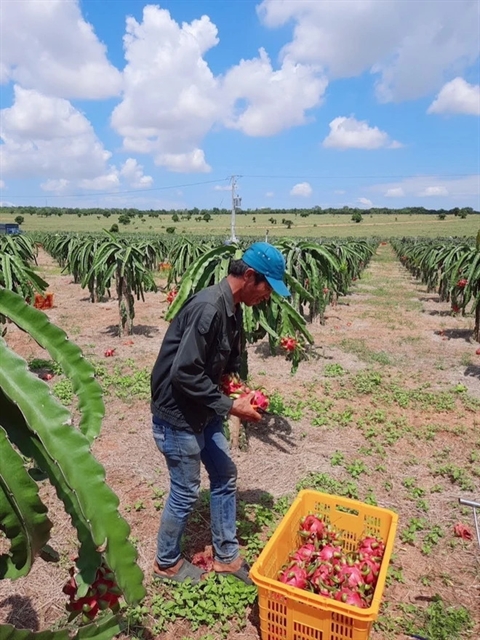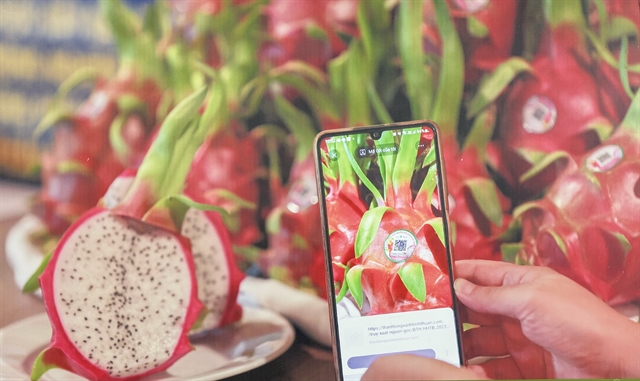 Society
Society

 |
| Harvesting dragon fruit in Bình Thuận Province. — VNA/VNS Photo |
Khánh Dương
BÌNH THUẬN — Dragon fruit is the main source of income for local people in south-central Bình Thuận Province, the largest dragon fruit growing area in Việt Nam.
But traditional growing methods require farmers to waste a lot of energy as they use 75-watt light bulbs to heat up and stimulate the production on cloudy days.
If they continue this traditional method, they will miss out on global market opportunities amid growing customer choice for green agricultural products.
Thanks to the assistance of the Ministry of Agriculture and Rural Development and the UN Development Programme, Bình Thuận’s farmers can find a solution by switching to 9-watt energy-saving LED lights for their growing areas.
Lê Phương Chi, director of Hàm Minh 30 Dragon Fruit Production and Service Cooperative, said the LED lights save costs and bring higher efficiency.
Đoàn Anh Dũng, chairman of Bình Thuận Province People’s Committee, said more than 80,000 LED lights with capacity of 9-watts each have been used at four local dragon fruit cooperatives/enterprises, saving 50 per cent of electricity consumption and reducing emissions by 68 per cent.
Rooftop solar-powered irrigation systems and other water-saving technologies installed at dragon fruit gardens led to a 42 per cent drop in water consumption, saving each farm at least VNĐ600,000 (US$25) per ha.
Carbon footprint, a figure to evaluate the green level of the production process or the efficiency in using resources in the dragon fruit production, has been managed to allow the dragon fruit produced in Bình Thuận be able to meet strict global standards.
Since 2022, a carbon footprint tracking tool, or a real-time online dragon fruit record, has been developed to manage carbon emissions during the processing and packaging process.
Customers now can easily scan QR codes on the fruit to track its origin and know how much carbon dioxide was emitted during the production and packaging process of the fruit they are holding.
According to the provincial Department of Agriculture and Rural Development, as of December 2023, about 8,640ha of dragon fruits which produce 23,300 tonnes of fruit per year have applied the tracking tool.
Chi from Hàm Minh 30 Cooperative said: “This tool is an improvement on the traditional hand-written tracking method, and increasing the transparency of each product being sold to customers.”
Lê Văn Kha, from Hoà Lệ Dragon Fruit Cooperative, added: “Recently I signed a contract with a company to export a massive amount of dragon fruit from my farm to Europe. The director visited by farm in person and was satisfied with the process of monitoring emissions and the GlobalGAP standard applied on my farm.”
 |
| A QR code on dragon fruit is scanned to trace the carbon footprint. — Photo courtesy of UNDP |
Chairman Dũng said the GlobalGAP standard has helped cooperatives and enterprises to be qualified to sign export contracts with high-quality markets like Europe, Australia.
This has marked the success in the sustainable and responsible production and export of dragon fruits in Bình Thuận Province, helping cooperatives and businesses have enough conditions for signing contracts for sustainable consumption, he said.
Phan Văn Tấn, deputy director of the provincial Department of Agriculture and Rural Development, said the online fruit record has been applied on some other key fruit products of the province like apple, durian.
The department is making efforts to promote the market consumption of high-quality products based on new strengths of the current traceability system and carbon footprint, thereby creating motivation to green development and digital development in a synchronous and drastic way, towards high-quality markets, he said.
Green trends
Nguyễn Đỗ Anh Tuấn, head of International Cooperation under the Ministry of Agriculture and Rural Development, said dragon fruit has been identified as one of 14 key fruits of Việt Nam.
Customers are changing their shopping habit and prefer green products with more nutritious, green, better-quality food. That’s the trend Việt Nam has to follow, he said.
Developing growing areas of dragon fruit must bring into full play advantages of eco areas, especially three key farming dragon fruit areas in Việt Nam – Bình Thuận, Long An and Tiền Giang, he said.
He said growing dragon fruit must go hand in hand with improving its quality, increasing added values, protecting the environment and adapting to climate change.
“Protecting the environment and adapting to climate change, in particular, are key tasks. Only when we ensure these, can we keep up with the green trend of the market.
“Green consumption with clear origin will reduce production costs and help Việt Nam fully realise international commitments on green growth and low carbon emissions.
"To develop dragon fruit sustainably, all of us - experts, scientists, State and local management agencies, businesses, associations, investors, distributors, consumers and farmers need to coordinate together to solve the limitations and difficulties of the dragon fruit industry."
The Ministry of Agriculture and Rural Development will work with localities and businesses in seeking partners and expanding dragon fruit export markets from the 16 signed FTA agreements, including three new generation agreements: Comprehensive and Progressive Agreement for Trans-Pacific Partnership (CPTTP), EU-Vietnam Free Trade Agreement (EVFTA) and Regional Comprehensive Economic Partnership Agreement (RCEP).
We will continue to develop more domestic distribution channels and enhance trade promotion for products processed from dragon fruit, he said. — VNS